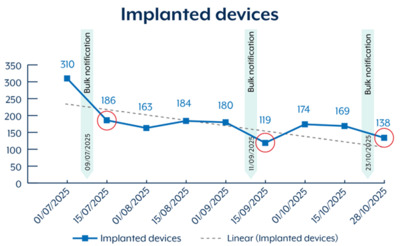Cisco devices still being exploited by BADCANDY since 2023

The Australian Cyber Security Centre has warned that cyber actors are still installing an implant dubbed ‘BADCANDY’ on Cisco IOS XE devices that are vulnerable to CVE-2023-20198, despite the age of the known vulnerability and the availability of a patch. Variations of the BADCANDY implant have been observed since October 2023, with renewed activity notable throughout 2024 and 2025.
BADCANDY is a low-equity Lua-based web shell, and cyber actors have typically applied a non-persistent patch post-compromise to mask the device’s vulnerability status in relation to CVE-2023-20198. In these instances, the presence of the BADCANDY implant indicates compromise of the Cisco IOS XE device, via CVE-2023-20198.
The BADCANDY implant does not persist following a device reboot; however, where an actor has accessed account credentials or other forms of persistence, the actor may retain access to the device or network. The patch for CVE-2023-20198 must be applied to prevent re-exploitation. Access to the web user interface should also be restricted if enabled.
Since July 2025, the Australian Signals Directorate (ASD) estimates that over 400 devices were potentially compromised with BADCANDY in Australia, and as of late October 2025, there are still over 150 devices compromised.
CVE-2023-20198
This critical vulnerability affects the web user interface (UI) feature of Cisco IOS XE software. Exploitation of this vulnerability could allow a remote, unauthenticated user to create a highly privileged account on the vulnerable system, allowing them to take control of the system.
This vulnerability has been leveraged by actors such as Salt Typhoon and was one of the top routinely exploited vulnerabilities in 2023. ASD is aware of ongoing exploitation.
While any actor can use this implant, ASD believes that criminal and state-sponsored cyber actors may leverage the BADCANDY implant. Cyber actors are known to re-exploit previously compromised devices where the device has not been patched and the interface has been left exposed to the internet. This presents an ongoing risk to Australian networks.
ASD has sent victim notifications to entities via their service provider if ASD cannot determine the system operator. These notifications contain instructions to patch and reboot the device, perform hardening, and conduct incident response on any impacted devices.
ASD will continue to conduct victim notifications to ensure system operators are aware that their device has been compromised.
What you and your organisation can do
ASD recommends that system operators take the following actions to remove the BADCANDY implant if compromised and to mitigate the risk of re-exploitation. These actions will not only assist organisations, they will help reduce the number of devices compromised with the BADCANDY implant in Australia.
- Review the running configuration for accounts with privilege 15 and remove unexpected or unapproved accounts.
- Accounts with random strings or ‘cisco_tac_admin’, ‘cisco_support’, ‘cisco_sys_manager’ or ‘cisco’ should also be reviewed and removed if not legitimate.
- Review the running configuration for unknown tunnel interfaces. Tunnels appear in the running configuration as ‘interface tunnel[number]’, followed by the IP address, tunnel source and tunnel destination.
- If enabled, review TACACS+ AAA command accounting logging for configuration changes for these compromised devices.
Patch against CVE-2023-20198
All Australian organisations using the web UI feature of Cisco IOS XE software are strongly encouraged to apply the patch and follow the recommendations detailed in Cisco’s security advisory ‘Multiple Vulnerabilities in Cisco IOS XE Software Web UI Feature’.
Cisco also reports active exploitation of this vulnerability and has published indicators of compromise to assist system owners in investigating for signs of malicious activity.
Device owners should also follow the advice in the ‘Cisco IOS XE Software Hardening Guide’, particularly in relation to ensuring that the HTTP server feature is disabled.
Edge devices are critical network components. ASD recommends implementing key strategies for securing edge devices aimed at enhancing network security and reducing vulnerabilities.
Below is a graph that shows the number of BADCANDY implanted devices from July 2025 to October 2025. ASD has marked when bulk victim notifications took place.

ASD believes actors are able to detect when the BADCANDY implant is removed and are re-exploiting the devices. This further highlights the need to patch against CVE-2023-20198 to avoid re-exploitation.
ACSC releases new guidance on bulletproof hosting providers
The ACSC has released new guidance on defence against potential cybercriminal activity enabled by...
IT security governance still lacking for many NSW agencies: report
A recent audit report finds there are still significant deficiencies in IT controls and...
ACSC publishes defensible architecture advice
The Australian Cyber Security Centre has released a new publication series on modern defensible...




